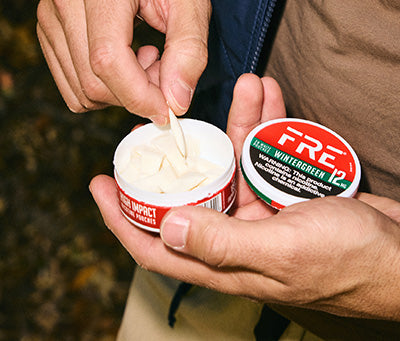Mixed martial arts isn’t just about stepping in the cage and throwing hands. It’s a full-body grind that builds strength, stamina, speed, and skill. And if you’ve seen Kevin “Trailblazer” Holland fight, you already know the kind of intensity we’re talking about.
Holland is consistent in training, follows a strict MMA workout plan, and pushes himself daily to stay ready. You don’t have to be UFC-bound to train like a pro, though. With the right routine, you can build a body that performs like a fighter’s, even if you’re just training for fitness.
And while we’re talking about staying ready, a packed gym bag goes a long way. You’ve got your gloves, wraps, gear and yeah, something to keep your energy up between sets. At FRE, we know how real training gets, so we made sure you’ve got fresh options like our Mint, Sweet, and Wintergreen pouches ready when you need that no-mess reset between sessions.
Let’s break down how to train like a pro fighter without having to take punches to the face.
What Are the Core Components of an MMA Training Plan?
An MMA training plan isn’t just lifting weights or doing cardio. It’s a balanced program that targets power, conditioning, flexibility, fight skills, and mental focus. Let’s go over each part.
Strength & Power Training
You can’t throw hard shots or slam someone to the ground without power. Fighters like Kevin Holland rely on strength training to build explosive force that shows in every strike, sprawl, and takedown.
Key exercises include:
-
Deadlifts
-
Squats
-
Pull-ups
-
Power cleans
-
Kettlebell swings
We recommend compound movements. These train multiple muscle groups and simulate the full-body demand of actual fights. Think fewer curls, more cleans.
Cardiovascular Conditioning
Fighting is about lasting through five hard rounds. Conditioning is what separates amateurs from those who can push the pace like Holland does in his later rounds.
Common cardio drills:
-
Sprint intervals
-
Jump rope circuits
-
Rowing machine sessions
-
Battle ropes
-
Hill runs
You want to train both steady-state and high-intensity intervals. This builds a gas tank that doesn't quit.
Flexibility & Mobility
Flexibility keeps you moving well. Mobility keeps you from locking up. MMA involves constant movement in awkward positions, kicks, sprawls, and submissions, so a tight body won’t cut it.
What to focus on:
-
Dynamic stretching before workouts
-
Static stretching post-training
-
Foam rolling
-
Yoga or mobility drills
Doing this consistently keeps your joints healthy and your movements sharp.
Skill Work
You can be jacked and have insane cardio, but if your technique’s trash, it shows fast in a fight. Skill work builds muscle memory and sharpens your instincts.
Focus areas include:
-
Striking: pads, mitts, heavy bag, shadowboxing
-
Grappling: wrestling, jiu-jitsu, clinch work
-
Footwork and timing drills
-
Light sparring for application
Holland has knockout power but also slick grappling. That balance comes from drilling all aspects of the fight game regularly.
Mental Conditioning
This part gets skipped a lot. But any serious MMA workout routine needs to train your mental strength. From handling pressure to bouncing back after a hard round, mindset matters.
How fighters build it:
-
Controlled breathing techniques
-
Visualization drills
-
Staying consistent even when motivation fades
-
Learning from past losses and wins
Kevin Holland’s ability to keep cool, even when getting trash-talked mid-fight, shows mental toughness built in training.
And while we’re on consistency, keeping your daily flow simple helps too. We’ve seen fighters and gym rats stash our FRE Original Mega Packs in their lockers so they’re not digging through pockets mid-break.
What Does a Weekly MMA Workout Routine Look Like?
Training like a fighter follows a structured weekly MMA workout routine that rotates between strength, cardio, skills, and recovery. You don’t need to train like a UFC athlete every day, but following this kind of layout builds functional fitness that works in and out of the cage.
Let’s take a look at a sample week inspired by how Kevin “Trailblazer” Holland gets after it.
Day 1: Strength & Power Training
Starting the week with strength builds your base. Kevin Holland’s explosive movement and takedown defense are no accident, he’s strong through the core and legs.
Go for compound lifts:
-
Deadlifts (5 sets x 5 reps)
-
Barbell back squats (4 sets x 6 reps)
-
Pull-ups (4 sets to failure)
-
Kettlebell swings (3 rounds, 30 seconds each)
Power drives performance, and these moves train multiple muscle groups in real-life patterns. Aim to move heavy with control.
Day 2: Cardiovascular Conditioning
This is where your lungs catch fire in a good way. Conditioning for MMA fighters keeps them performing well into the later rounds.
Try this:
-
5 x 30-second sprints with 90 seconds rest
-
3 minutes jump rope, 3 rounds
-
4 sets of 1-minute battle ropes
-
Rowing machine: 10 minutes at moderate pace
Day 3: MMA-Specific Training
Time to sharpen your actual fight tools. This is what separates general fitness from mixed martial arts exercises. Technique, timing, and coordination come from reps.
Drills to include:
-
Shadowboxing (3 rounds x 3 minutes)
-
Heavy bag work (3 rounds striking + footwork)
-
Pad or mitt work with a partner
-
Wrestling entries and takedowns
-
Clinch drills against the wall
Kevin Holland’s success inside the cage is all about being well-rounded. He switches from striking to grappling without pause. That’s from putting in this type of work consistently.
Day 4: Active Recovery & Flexibility
No, it’s not a day off but your body gets a break from impact. This keeps you loose and injury-free.
Options for recovery:
-
Swimming laps or water aerobics
-
Yoga or guided stretching
-
Foam rolling major muscle groups
-
Light shadowboxing or bag work at 50% effort
Flexibility improves movement, and mobility keeps you pain-free over time.
Need a tip for gym bag must-haves? Our Moisture Level Guide breaks down how FRE pouches hold up through long sessions without getting messy or dry. Worth checking if you like a steady pack that won’t quit halfway through your routine.
Day 5: High-Intensity Circuit Training
This simulates fight conditions. It’s fast, intense, and makes you tired quick. The goal here is to stay explosive under fatigue.
Sample circuit:
-
Kettlebell swings x 20
-
Burpees x 15
-
Medicine ball slams x 20
-
Jump squats x 15
-
Push-ups x 25
Repeat that for 3 to 5 rounds. Minimal rest. Think fast transitions, maximum effort. Holland’s ability to keep pace late in fights is built on circuits like this.
Day 6: Sparring & Fight Simulations
Now it’s time to put everything together. Light sparring develops timing, range, and defensive reflexes.
Key activities:
-
Light technical sparring (boxing, kickboxing)
-
Wrestling scrambles
-
Cage control drills
-
Flow rolling in jiu-jitsu
Kevin Holland is known for adapting fast in fights. Controlled sparring sessions help you develop the same responsiveness. You can’t just train solo and expect to fight well, you need to see different looks and solve problems in real time.
Day 7: Rest & Recovery
This is where gains happen. Rest helps muscles repair and keeps your central nervous system ready for another week. Even pro fighters respect recovery days.
Tips:
-
Get 7–9 hours of sleep
-
Hydrate and eat well
-
Stretch lightly
-
Avoid intense movement
-
Foam roll tight areas
What Should You Eat on an MMA Workout Plan?
You can’t train like a fighter and fuel like a couch potato. Nutrition plays a big part in every MMA workout plan as it supports recovery, strength gains, and stamina during hard rounds. Here’s how most MMA athletes structure their meals.
Macronutrient Breakdown
-
Protein builds and repairs muscle. Chicken, beef, tofu, beans, and eggs are common go-tos.
-
Carbs fuel workouts. Fighters often eat more carbs on high-intensity training days.
-
Fats help with energy regulation and joint health. Healthy sources like avocado, olive oil, and nuts work well.
Carb cycling is popular in fight camps. It lets you fuel up when you need the energy but cut down when you're trying to stay lean. It’s all about balance and knowing when to load and unload.
Stay Hydrated
MMA training means constant sweating. Fighters drink water, add electrolytes, and avoid sugary drinks. Weight cuts are intense, but hydration during regular training days should be consistent.
BCAAs and creatine are also used by some athletes to maintain muscle and energy levels. But always check the label and stay smart about what you take.
Snacks and Breaks Matter
Long training sessions call for breaks, and not just for stretching. Having something simple that doesn’t mess up your focus is helpful. Our FRE Pouch Lineup was made for active adults who need something in between meals and sessions. Zero mess. Zero smoke.
Try our Lush or Original options if you want to mix up the flavor rotation.
What Are Some Tips for Beginners Starting an MMA Fitness Routine?
Getting started in mixed martial arts exercises can feel overwhelming. But you don’t have to jump into full-contact sparring to make progress. Start smart and build from there.
Here’s what we recommend:
-
Start with 2-3 days per week. Let your body adapt before adding more training days.
-
Learn basic techniques first. Focus on form before going hard. This prevents injury.
-
Mix strength, cardio, and skills. A full MMA training plan includes all three.
-
Stick with it. Discipline beats motivation every time.
-
Train your mind too. Like Kevin Holland, mental sharpness comes from doing hard things regularly.
You’re New? That’s Cool. So Were We.
No one starts as an expert. If you’re training after work, between classes, or just for fun, you’re in the right place. A beginner MMA workout doesn’t need to be complicated. Just keep showing up and learning.
And if you need something lowkey for those gym bag moments, check out our Store Locator to find FRE pouches near you. Sometimes it’s those little wins, like not having to search forever for a clean option, that keep your momentum going.
Final Words
Kevin “Trailblazer” Holland didn’t earn that nickname sitting still. His MMA training plan includes:
-
Strength sessions for power
-
Cardio conditioning for endurance
-
Skill work across striking and grappling
-
Mental toughness from staying consistent
-
A weekly structure that balances training and recovery
-
Clean, functional nutrition to support performance
You don’t have to fight in the UFC to train like a fighter. All it takes is a plan, effort, and a mindset that doesn’t flinch.
Start building your own MMA workout routine today. Keep it consistent, stay smart, and track your progress. Want more tips and access to stuff that actually works for your daily grind? Sign up for our newsletter





